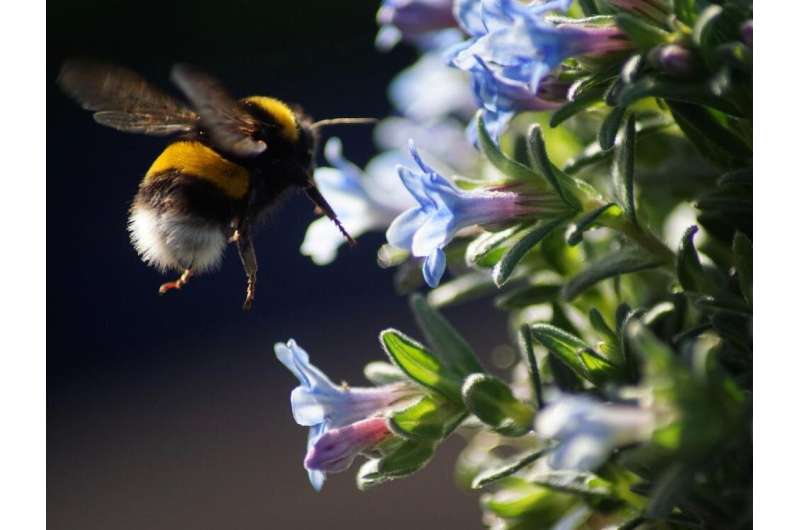This article has been reviewed according to Science X's editorial process and policies. Editors have highlighted the following attributes while ensuring the content's credibility:
fact-checked
peer-reviewed publication
trusted source
proofread
Soil nutrients affect how attractive plants are to bees from the ground up, shows study

Pollination is vital for many plants, and nutrients present in the soil before these plants even sprout may affect how attractive they eventually are to pollinators, according to Penn State-led research.
In a study with cucumber plants, the researchers found that in general, higher amounts of nitrogen and phosphorus in the soil resulted in larger plants and floral display, including flower number and size, leading to increased attractiveness to pollinators and increased fruit production.
However, they also found that regardless of nitrogen and phosphorus levels, pollinator "rewards" such as sugar content in nectar, the amount of nectar in female flowers, and protein and lipid concentrations in pollen stayed the same.
Anthony Vaudo, a USDA Forest Service research biological scientist who led the research while a postdoctoral scholar in entomology in Penn State's College of Agricultural Sciences, said these findings—recently published in Scientific Reports—suggest that plants may prioritize these rewards in all conditions to ensure that they attract pollinators.
"We found that a plant could become more attractive with the help of certain nutrients in the soil, while also keeping the quality of its rewards consistent, which is necessary for getting bees to visit," Vaudo said. "This gives us clues for how we can best restore soil, for example, after disturbance from human activity or natural disasters."
According to the researchers, previous studies have found an association between higher nitrogen and phosphorus in the soil and faster plant growth, as well as positive effects such as number and size of flowers and pollen number and size. However, little work had been done on how these nutrients affect pollinator attraction and, ultimately, plant reproduction.
Christina Grozinger, Publius Vergilius Maro Professor of Entomology at Penn State, said that because soil nutrient conditions can change as a result of land use, climate change and land management—such as fertilizers and grazing livestock—it is vital to learn more about how these nutrients affect plant growth.
"With three quarters of our food crops using pollinators to set fruit and seed, and more than 80% of flowering plants benefiting from pollinators," Grozinger said, "it is incredibly important that we begin to understand and predict how these changes in soil conditions influence plant-pollinator interactions both in crops and in natural landscapes."
For the study, the researchers raised cucumber plants in Penn State greenhouses. They treated the plants with one of five fertilizer solutions: a control that had no added nitrogen or phosphorus and four others with different nitrogen and phosphorus concentrations and ratios.
The researchers measured several characteristics of the plants, including height and above-ground biomass, the size of each plant's male and female flowers, how many flowers each plant produced, how long it took the plants to start producing flowers after seeding, and how many cucumbers each plant produced. They also analyzed the flowers' nectar and pollen, as well as how often the flowers were visited by bumblebees.
After analyzing the data, the researchers found that while more nitrogen and phosphorus generally was associated with increased growth, attractiveness to pollinators and fruit production, very high levels of nitrogen began to have negative effects on some of these traits. However, increasing phosphorus levels could then mitigate this.
Overall, they found that the ideal ratio of nitrogen to phosphorus that they tested was 4:1, which resulted in best overall growth, pollinator attraction and reproduction.
Junpeng Mu, a researcher at Mianyang Normal University who visited Penn State while working on this project, said he thought it was particularly interesting that certain traits of the male flowers—such as number and size of flowers per plant, nectar concentration and pollen number per flower—varied with soil nutrients, but traits of the female flowers did not.
"These findings give us a better understanding of the mechanisms that underlie interactions between plants and pollinators," Mu said, "as well as agricultural ecosystem operations."
Additionally, Vaudo said he expects the findings will also be useful in his current position, in which he'll be part of an effort to rehabilitate areas of forests that have been logged. He said the soil is often very compact from the heavy machinery that has rolled through these areas, as well as lacking in nutrients.
"After loosening the soil, we'll apply a material called biochar to increase the soil's ability to hold water and bind nutrients," Vaudo said. "Then, we can start reintroducing plants and pollinators to the area. I'm thankful to have the experience from this study, which gave me a good starting ground for actually doing some real-life applications."
More information: Anthony D. Vaudo et al, Impacts of soil nutrition on floral traits, pollinator attraction, and fitness in cucumbers (Cucumis sativus L.), Scientific Reports (2022). DOI: 10.1038/s41598-022-26164-4
Journal information: Scientific Reports
Provided by Pennsylvania State University


















